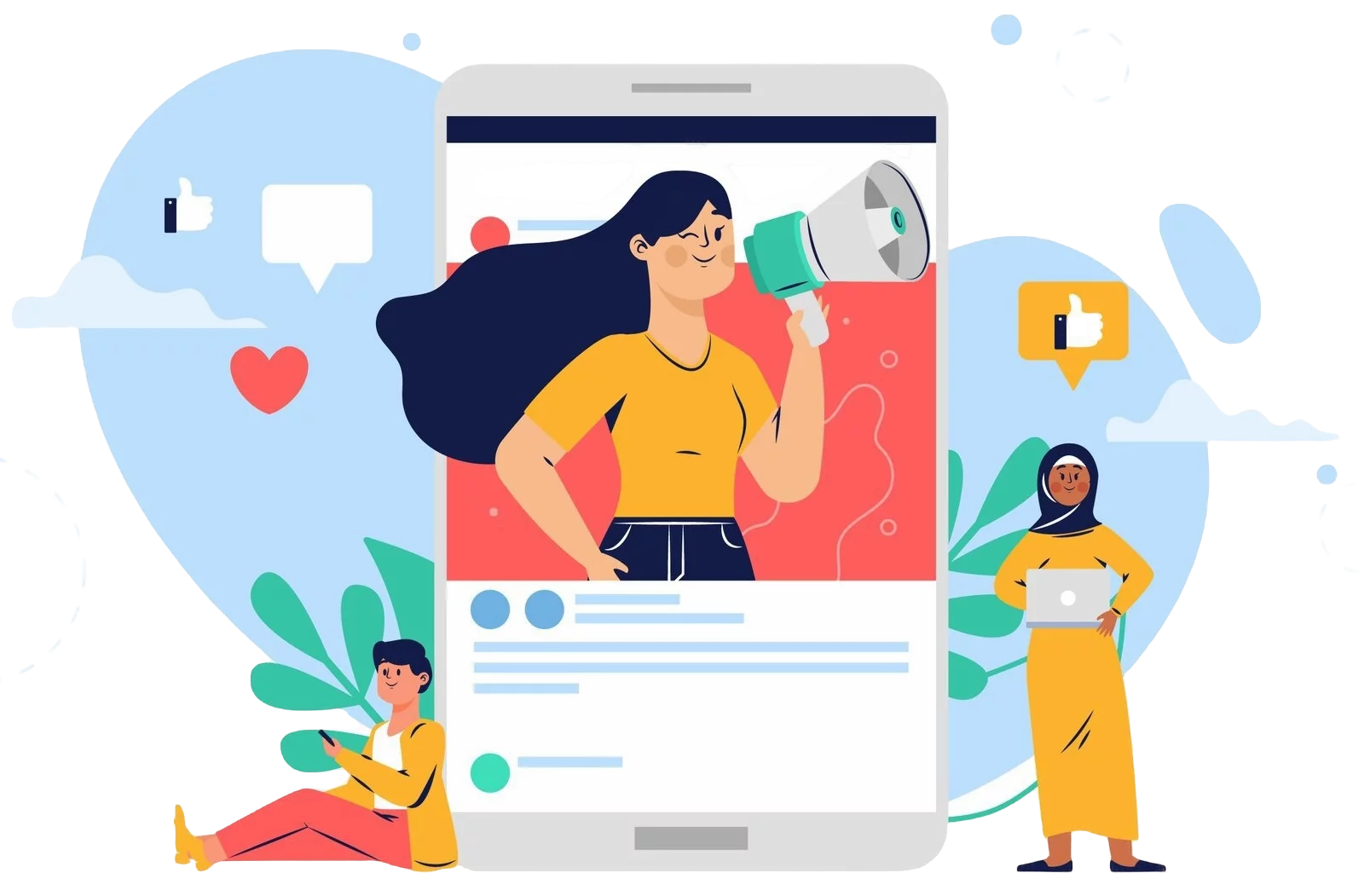Influencer marketing is perpetually evolving; in 2025, it will further transform the manner in which brands interact with their target audiences. The trends in influencer marketing which are becoming increasingly diverse and dynamic are accompanied by new strategies and techniques that businesses must adopt to remain competitive. In this article, we will examine the top 5 influencer marketing trends to watch that every marketer ought to monitor. Although these emerging trends will significantly influence the way brands engage with influencers, this will also affect how they implement social media influencer strategies in 2025. However, it is essential to recognize the importance of adapting to these changes.
1. Micro-Influencers and Niche Audiences Dominate
In recent years, the discussion surrounding micro versus macro influencers has intensified; however, by 2025, it is evident that micro-influencers are gaining greater significance for brands. Why is this the case? Because small-scale influencers generally exhibit elevated engagement rates and cultivate more personal relationships with their followers. They possess the ability to generate authentic brand messaging, which is crucial in today’s marketing environment. Brands are redirecting their attention to these influencers, as their communities tend to be more engaged and they frequently result in increased social media interaction.
Why Micro-Influencers are So Effective:
- Targeted Reach: Micro-influencers often cater to specific niche audiences, which means brands can be more precise in their targeting.
- Better Engagement: These influencers have stronger relationships with their followers, resulting in more audience interaction.
- Cost-Effectiveness: Brands find it easier to collaborate with micro-influencers as they tend to charge less compared to larger influencers.
By the year 2025, it is anticipated that numerous brands will increasingly engage in partnerships with micro-influencers these creators hold significant sway due to their capacity to foster enhanced brand loyalty and trust. This occurs primarily through user-generated content (UGC), which often appears more authentic and relatable. However, some may question the effectiveness of such strategies, but the trends suggest otherwise. Although these partnerships can be beneficial, the true impact lies in the quality of the content produced, because authenticity resonates with audiences.
2. The Rise of User-Generated Content (UGC)
User-generated content is not just a buzzword anymore. It has become a must-have in any influencer campaign planning. Customer-created content will continue to rise in 2025 as consumers increasingly seek authenticity in the brands they follow. More than just a marketing tool, UGC builds stronger social media communities, allowing consumers to feel part of the brand’s story. As brands aim for higher brand authenticity in influencer marketing, consumer-generated content will be a vital part of their strategy.
How UGC Benefits Brands:
- Increases Trust: UGC provides social proof, which can help potential customers trust your brand more.
- Cost-Effective Content Creation: UGC is often free or cost-efficient to use in campaigns, making it an attractive option for marketers.
- Engagement and Loyalty: UGC campaigns drive higher engagement rates, creating a community of loyal followers.
UGC (user-generated content) is poised to remain relevant in 2025; brands must explore innovative strategies to motivate their audiences to contribute content. This content however can be repurposed in influencer collaborations. Although the landscape is ever-evolving, engaging audiences is crucial because it fosters a sense of community and brand loyalty. Brands should not underestimate the power of collaboration, but rather embrace it as a means to amplify their reach.
3. Video Content Takes Center Stage
By 2025, video content is expected to persist in dominating the social media landscape. Various platforms such as TikTok, Instagram and YouTube will still play a pivotal role in influencer marketing campaigns. However, video content is likely to evolve, transitioning beyond mere product reviews or shoutouts. Influencers will develop immersive and captivating content, employing visual storytelling techniques to establish connections with their audiences. Although it may be through stories, reels, or livestreams, brands will prioritize influencers capable of generating shareable video content, because this is essential for engagement.
Why Video Content is Essential for Influencer Marketing:
- Higher Engagement Rates: Video content tends to have higher engagement compared to static images or text-based posts.
- Increased Reach: Videos are shared more frequently, increasing brand visibility.
- Effective Communication: Video allows for more detailed storytelling, which helps in delivering a message in an engaging and memorable way.
Influencer marketing case studies which illustrate the success of video-driven campaigns suggest that brands will, however, increasingly pursue influencers who excel at social media video creation. This is crucial to maintain a competitive edge, because the visual appeal of video content is undeniable. Although challenges exist in finding the right influencers, the benefits far outweigh the difficulties.

Amplify Your Brand,
One Influence at a Time.
4. Focus on Long-Term Influencer Collaborations
Instead of isolated influencer marketing campaigns, 2025 will witness an increasing trend toward sustained influencer collaborations. Brands are beginning to grasp the significance of cultivating deeper, ongoing relationships with influencers. This approach enables brands to preserve consistency in messaging and guarantees that their products or services remain consistently visible to the target audience. Influencers, however, profit from these relationships, as they enhance their credibility and emerge as trusted ambassadors for the brand. Although the landscape is evolving, this shift reflects a mutual benefit for both parties involved.
Why Long-Term Influencer Partnerships Work:
- Consistency in Messaging: Ongoing collaborations help brands maintain a consistent voice and messaging over time.
- Stronger Relationship: Both brands and influencers develop a stronger partnership, leading to more genuine promotions.
- Increased ROI: Long-term partnerships are often more cost-effective and provide better returns compared to short-term campaigns.
By the year 2025 which is just a few years away, collaborations between influencers and brands will emerge as crucial for fostering brand loyalty. Brands, however, will increasingly allocate resources to cultivate these enduring relationships. This shift signifies a growing recognition of the importance of such partnerships. Although some may question the efficacy of these strategies, the trend indicates a clear direction in marketing.
5. The Role of Artificial Intelligence in Influencer Marketing
Artificial Intelligence (AI) is rapidly infiltrating influencer marketing; indeed, its impact is significant. AI-driven tools are being utilized to assist brands in locating the most suitable influencers with greater efficiency. These tools which can process extensive datasets analyze various factors, such as audience engagement, sentiment analysis and even prior campaign success. Because of AI’s capabilities, brands can track influencer marketing performance effectively; this enables them to make informed decisions based on data and optimize their campaigns for maximum impact. However, some may argue that reliance on technology could overshadow the human element. Although AI provides valuable insights, it is essential to remember the importance of genuine connections in marketing.
How AI is Transforming Influencer Marketing:
- Efficient Influencer Discovery: AI tools can analyze data to recommend the best-fit influencers for a brand’s goals.
- Enhanced Campaign Management: AI can automate tasks such as scheduling posts and measuring campaign success, saving marketers time.
- Data-Driven Insights: Brands can use AI to gain insights into the effectiveness of influencer partnerships, helping them fine-tune their approach.
By the year 2025, AI-powered influencer marketing tools are set to become indispensable for brands that seek to optimize their marketing strategies. However, this advancement will ensure not only the success of influencer marketing campaigns but also enhance overall efficiency. Although many brands may hesitate to adopt these technologies, they will find it increasingly difficult to compete without them. Because of this, embracing AI tools will likely be a crucial step for brands aiming to thrive in a competitive landscape.
Conclusion
The influencer marketing trends to watch in 2025 will continue to evolve, but the importance of authenticity, micro-influencers, UGC, and video content will remain at the forefront of successful campaigns. Brands will increasingly rely on long-term influencer collaborations and AI-driven tools to optimize their campaigns and achieve better results. As the social media influencer strategies and landscape continue to shift, staying ahead of these emerging influencer marketing strategies will be crucial for businesses looking to engage with their audiences in meaningful ways.
About Hobo.Video
When it comes to Influencer Marketing Insights 2025, Hobo.Video is here to help you navigate these changes. Whether you are looking to harness the power of micro-influencers or create authentic UGC content, Hobo.Video offers customized strategies that align with your brand goals. With our data-driven approach, we ensure your influencer marketing campaigns yield the best results. Hobo.Video has a proven track record in executing successful influencer campaigns across multiple niches, helping brands grow by leveraging the latest influencer marketing developments.
If you are a brand looking for unconventional hypergrowth. Connect with us Here

